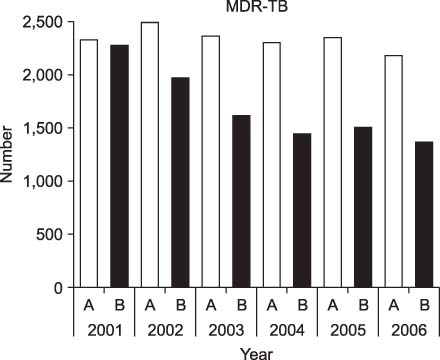Tuberc Respir Dis.
2010 Mar;68(3):146-154. 10.4046/trd.2010.68.3.146.
The Recent Status of Multidrug- and Extensively Drug-Resistant Tuberculosis in Korea
- Affiliations
-
- 1Division of Pulmonary and Critical Care Medicine, Asan Medical Center, University of Ulsan College of Medicine, Seoul, Korea. shimts@amc.seoul.kr
- 2Korean Institute of Tuberculosis, Seoul, Korea.
- 3Seoul Medical Science Institute, Seoul, Korea.
- 4Green Cross Reference Laboratory, Seoul, Korea.
- 5Neodin Medical Institute, Seoul, Korea.
- 6National Masan Hospital, Masan, Korea.
- 7National Mokpo Hospital, Mokpo, Korea.
- 8Seobuk Hospital, Seoul, Korea.
- KMID: 1728959
- DOI: http://doi.org/10.4046/trd.2010.68.3.146
Abstract
- BACKGROUND
The increasing incidence of multidrug-resistant tuberculosis (MDR-TB) and extensively drug-resistant tuberculosis (XDR-TB) has become a serious worldwide problem. However, there is insufficient data regarding the current status of MDR-TB and XDR-TB in Korea. This study examined the recent status of MDR- and XDR-TB using the data from 7 laboratories, in which almost all drug susceptibility tests (DST) for Mycobacterium tuberculosis were performed.
METHODS
The patients' identification data and DST results were collected from all 7 laboratories from 2001 to 2006 and the number of patients with MDR-TB and XDR-TB were calculated.
RESULTS
The number of DSTs was 140,638 for 6 years with an increasing incidence each year (p<0.001). The number of DST with MDR results was 18,510 and personal identifying information was obtained in 16,640 (89.9%) tests. The number of MDR-TB patients from 2001 to 2006 was 2,329, 2,496, 2,374, 2,300, 2,354, and 2,178, respectively, when counting the duplications in a year as one patient. The number of MDR-TB patients when counting the duplications in 6 years as one patient was 2,281, 1,977, 1,620, 1,446, 1,512, and 1,373, respectively. When the same method was adopted, the number of XDR-TB patients was 191, 238, 282, 260, 272, and 264, respectively, and 189, 150, 130, 90, 122, and 110 patients, respectively.
CONCLUSION
Despite the national efforts to control TB, there are still a large number of MDR- and XDR-TB patients in Korea.
Keyword
MeSH Terms
Figure
Reference
-
1. Pablos-Méndez A, Raviglione MC, Laszlo A, Binkin N, Rieder HL, Bustreo F, et al. Global surveillance for anti-tuberculosis-drug resistance, 1994-1997: World Health Organization-International Union against Tuberculosis and Lung Disease Working Group on Anti-Tuberculosis Drug Resistance Surveillance. N Engl J Med. 1998. 338:1641–1649.2. Gandhi NR, Moll A, Sturm AW, Pawinski R, Govender T, Lalloo U, et al. Extensively drug-resistant tuberculosis as a cause of death in patients co-infected with tuberculosis and HIV in a rural area of South Africa. Lancet. 2006. 368:1575–1580.3. Velayati AA, Masjedi MR, Farnia P, Tabarsi P, Ghanavi J, Ziazarifi AH, et al. Emergence of new forms of totally drug-resistant tuberculosis bacilli: super extensively drug-resistant tuberculosis or totally drug-resistant strains in Iran. Chest. 2009. 136:420–425.4. Bai GH, Park YK, Choi YW, Bai JI, Kim HJ, Chang CL, et al. Trend of anti-tuberculosis drug resistance in Korea, 1994-2004. Int J Tuberc Lung Dis. 2007. 11:571–576.5. Bae GH. National tuberculosis control program in Korea: actions for TB elimination. Commun Dis Mon Rep. 2006. 17:1–10.6. Jeon D, Shin D, Kang H, Sung N, Kweon K, Shin E, et al. Trend of multidrug and extensively drug resistant tuberculosis in a tuberculosis referral hospital, 2001~2005. Tuberc Respir Dis. 2008. 64:187–193.7. Kim BJ, Lee IH, Lee DH, Bai GH, Kong SJ, Lee SH, et al. The current status of multidrug-resistant tuberculosis in Korea. Tuberc Respir Dis. 2006. 60:404–411.8. Case definition for extensively drug-resistant tuberculosis. Wkly Epidemiol Rec. 2006. 81:408.9. Wright A, Zignol M, Van Deun A, Falzon D, Gerdes SR, Feldman K, et al. Epidemiology of anti-tuberculosis drug resistance 2002-07: an updated analysis of the Global Project on Anti-Tuberculosis Drug Resistance Surveillance. Lancet. 2009. 373:1861–1873.10. Global map and information on XDR-TB: countries that had reported at least one XDR-TB case by September 2009 [internet]. World Health Organization. 2009. cited 2009 Dec 20. Geneva: World Health Organization;Available from: http://www.who.int/tb/challenges/xdr/xdr_map_sep09.pdf.11. Centers for Disease Control and Prevention. Emergence of Mycobacterium tuberculosis with extensive resistance to second-line drugs: worldwide, 2000-2004. MMWR Morb Mortal Wkly Rep. 2006. 55:301–305.12. Kim DH, Kim HJ, Park SK, Kong SJ, Kim YS, Kim TH, et al. Treatment outcomes and long-term survival in patients with extensively drug-resistant tuberculosis. Am J Respir Crit Care Med. 2008. 178:1075–1082.
- Full Text Links
- Actions
-
Cited
- CITED
-
- Close
- Share
- Similar articles
-
- Medical Management of Drug-Resistant Tuberculosis
- Medical Treatment of Pulmonary Multidrug-Resistant Tuberculosis
- Current status of drug-resistant tuberculosis and its treatment
- Drug Resistance Patterns of Multidrug- and Extensively Drug-Resistant Tuberculosis in Korea: Amplification of Resistance to Oral Second-line Drugs
- Extensively Drug Resistant-Tuberculosis, XDR-TB



